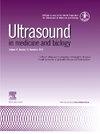老年人短期阻力训练后肌肉质量的变化:回声强度和肌理分析的比较。
IF 2.4
3区 医学
Q2 ACOUSTICS
引用次数: 0
摘要
背景:骨骼肌回声强度(EI)与老年人的功能预后相关,但阻力训练干预显示出不同的结果。纹理分析已被提出作为一种评估肌肉质量的新方法,因为它捕获像素之间的空间关系。目前尚不清楚纹理分析是否能够跟踪阻力训练后的变化。目的:探讨老年人下体阻力训练后肌肉质量一阶(EI)和二阶(质地)特征的变化。方法:老年人12例(男2例,女10例;平均±SD年龄= 70±5岁)完成了6周的阻力训练,包括每周两次的训练,估计1RM的85%。测试包括股直肌(RF)和股外侧肌(VL)的超声成像,5次重复最大腿部伸展强度(5RM)和最大自主等距收缩力(MVIC)。采用灰度共生矩阵(GLCM)分析超声图像的EI和纹理特征。结果:5RM组下肢伸展力量(p < 0.001,效应量[ES] = 2.09)、MVIC力(p = 0.006, ES = 0.969)和RF EI(未校正:p = 0.003, ES = 0.727;校正:p = 0.012, ES = 0.864)。两组肌肉的大小、VL EI或纹理特征均未见显著变化。结论:短期抗阻训练可提高力量和RF EI。然而,纹理分析特征对训练后的变化不敏感。这些发现表明,在追踪老年人阻力训练后肌肉质量的变化时,传统的EI测量可能比纹理分析更合适。本文章由计算机程序翻译,如有差异,请以英文原文为准。
Changes in Muscle Quality Following Short-Term Resistance Training in Older Adults: A Comparison of Echo Intensity and Texture Analysis
Background
Skeletal muscle echo intensity (EI) is associated with functional outcomes in older adults, but resistance training interventions have shown mixed results. Texture analysis has been proposed as a novel approach for assessing muscle quality, as it captures spatial relationships between pixels. It is unclear whether texture analysis is able to track changes following resistance training.
Objective
To examine changes in first-order (EI) and second-order (texture) features of muscle quality following lower-body resistance training in older adults.
Methods
Twelve older adults (2 males, 10 females; mean ± SD age = 70 ± 5 years) completed 6 weeks of resistance training, consisting of twice-weekly sessions at 85% of estimated 1RM. Testing included ultrasound imaging of the rectus femoris (RF) and vastus lateralis (VL), 5-repetition maximum (5RM) leg extension strength, and maximal voluntary isometric contraction (MVIC) force. Ultrasound images were analyzed for EI and texture features using gray-level co-occurrence matrix (GLCM) analysis.
Results
Large improvements were observed in 5RM leg extension strength (p < 0.001, effect size [ES] = 2.09), MVIC force (p = 0.006, ES = 0.969), and RF EI (uncorrected: p = 0.003, ES = 0.727; corrected: p = 0.012, ES = 0.864). No significant changes were observed in muscle size, VL EI, or texture features for either muscle.
Conclusion
Short-term resistance training improved strength and RF EI. However, texture analysis features were not sensitive to changes following training. These findings suggest that traditional EI measures may be more appropriate than texture analysis for tracking changes in muscle quality following resistance training in older adults.
求助全文
通过发布文献求助,成功后即可免费获取论文全文。
去求助
来源期刊
CiteScore
6.20
自引率
6.90%
发文量
325
审稿时长
70 days
期刊介绍:
Ultrasound in Medicine and Biology is the official journal of the World Federation for Ultrasound in Medicine and Biology. The journal publishes original contributions that demonstrate a novel application of an existing ultrasound technology in clinical diagnostic, interventional and therapeutic applications, new and improved clinical techniques, the physics, engineering and technology of ultrasound in medicine and biology, and the interactions between ultrasound and biological systems, including bioeffects. Papers that simply utilize standard diagnostic ultrasound as a measuring tool will be considered out of scope. Extended critical reviews of subjects of contemporary interest in the field are also published, in addition to occasional editorial articles, clinical and technical notes, book reviews, letters to the editor and a calendar of forthcoming meetings. It is the aim of the journal fully to meet the information and publication requirements of the clinicians, scientists, engineers and other professionals who constitute the biomedical ultrasonic community.

 求助内容:
求助内容: 应助结果提醒方式:
应助结果提醒方式:


